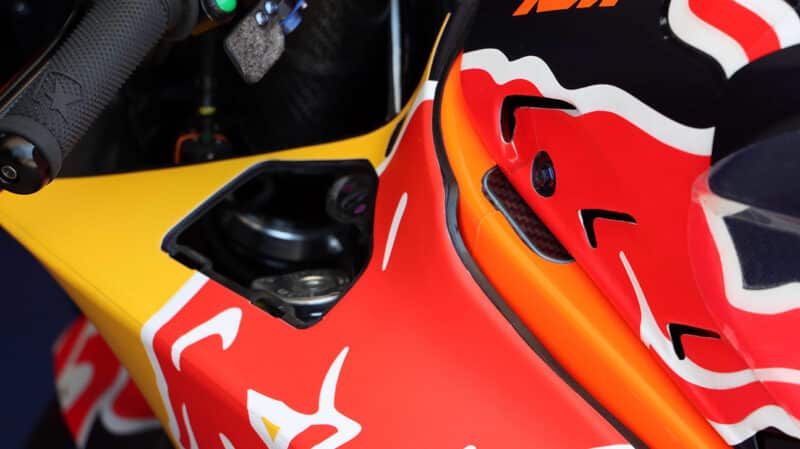KTM tech: ‘sooner or later everyone will have carbon-fibre frames’
Last September KTM introduced a carbon-fibre frame, which immediately gave the RC16 the most important thing of all: more grip.
There are many important advantages to using carbon fibre in racing. It’s lighter and stronger than steel and aluminium. Increased chassis rigidity allows the suspension to do a better job, which allows the tyres to follow the road better, which increases grip.
Carbon fibre also allows engineers to fine-tune chassis rigidity, by using different fibre weaves and laying them up in different ways.
And there’s another important plus to carbon fibre, which MotoGP engineers don’t talk about – carbon-fibre chassis components can actually understand themselves.
When engineers lay up a carbon-fibre frame they can lay electrical-conducting plastic fibres within the fibres and weaves to provide data that reveals exactly what kind of forces – bending, twisting and so on – each part is undergoing during every second of every lap. Thus carbon-fibre chassis could revolutionise knowledge of frame behaviour.

KTM introduced its carbon-fibre frame at Misano last September – only the small window in the orange cover reveals that this frame is carbon, not steel
Oxley
For all these reasons – and probably more – KTM is convinced that its rivals will soon switch from aluminium to carbon chassis. Aprilia has already started this process.
I spoke to KTM’s MotoGP technical manager Sebastian Risse at the end of last season to get the inside line on the RC16’s immediate past and future…
Oxley: You go into 2024 after making a big jump forward last season…
Risse: That was mainly a jump forward in consistency, which was our target. Consistency and qualifying positions were our targets and that’s what we saw.
What made that happen?
Working on how we can use the grip – how usable is the grip that we are producing? We worked on this in many different ways, from the engine, through the drivetrain, through chassis stiffness.
On top of this we worked on the electronics, especially with Jack coming into the team, because he came from a background where he was managing the bike a lot on his own, so with less resistance from the electronics. First, we tried to introduce this philosophy to help Jack. And second, because we believe it’s the correct approach and now we have a rider [Binder] that realised this and then we transferred this philosophy to our other riders.
What were the big positives of the 2023 RC16?
It allowed us to use the grip in a better way, which also helped us to improve our qualifying positions. In general it was rear grip, but not only on corner exit, also in entry.
In 2022 we had the impression that we could not use the extra grip we got from a new tyre, which is why we struggled in qualifying and over a single lap, so this was our target: to sacrifice something in ultimate grip to make the extra grip you get from the tyre more useable. [This fits with my recent blog about Wayne…
Read More: KTM tech: ‘sooner or later everyone will have carbon-fibre frames’ 2024-02-07 22:36:42
